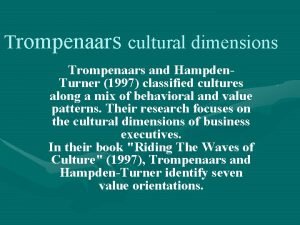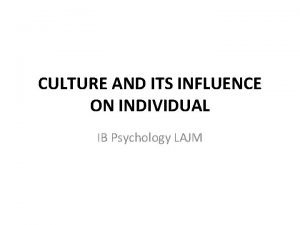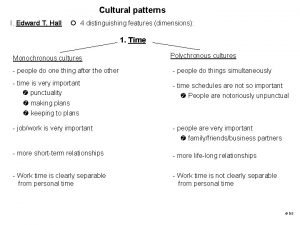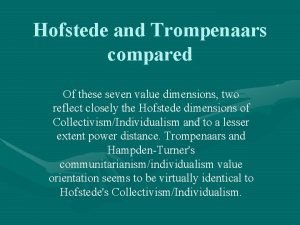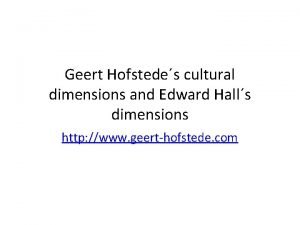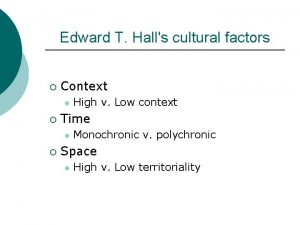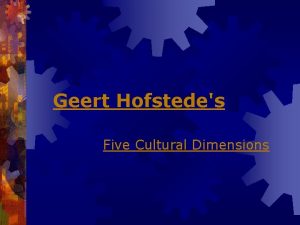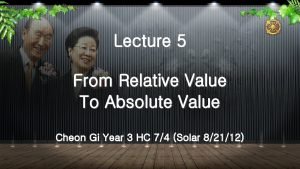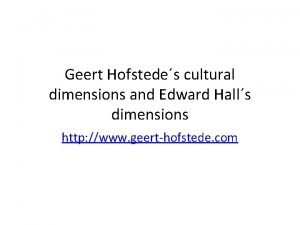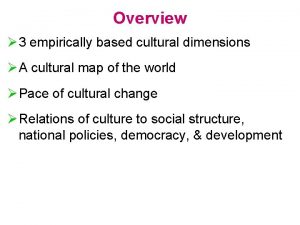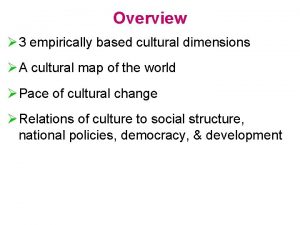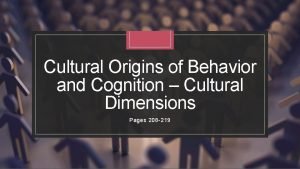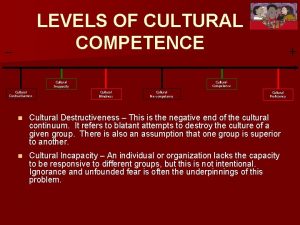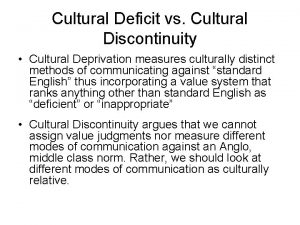Cultural value dimensions Topics 1 Cultural value dimensions






















- Slides: 22

Cultural value & dimensions

Topics 1. Cultural value dimensions Masculinity/Femininity Power distance Long term orientation Achievement v. s ascription Universalistic v. s particularistic Specific v. s. diffuse Affective v. s. neutral

Masculinity and Femininity Masculinity- refers to assertiveness, materialism, and a lack of concern for others Femininity- refer to a concern for others, for relationships, and for the quality of life In the GLOBE study, gender egalitarianism measures roles men and women are suited for – Denmark and New Zealand most gender egalitarian; Eastern Europe and Nordic Europe – Iran and Qatar are the least gender egalitarian; Middle East, Confucian Asia, Germanic Europe

In masculine cultures, there is division of gender roles Masculine cultures emphasize on work goals (earnings) and achievement In feminine cultures, the social gender roles overlap Feminine cultures emphasize on having a good working relationship with direct superior and cooperating well with one another

Major Differences between “Feminine” and “Masculine” Cultures "Feminine" cultures "Masculine" cultures Flexible sex roles Complementary sex roles Emphasize nurturance Emphasize achievements Quality of work life Economic growth Work in order to live Live in order to work Environmental issues Business performance Example Sweden Japan Netherlands Austria Costa Rica Italy Finland

Power distance Refer to the level of acceptance by a society of the unequal distribution of power in institution In large power distance cultures, superiors and subordinates consider each other as existentially unequal → organizations centralize powers as much as possible in few hands at the upper level Subordinates expect to be told what to do, the ideal boss plays the benevolent autocratic role Rewards and punishments based on age, rank, status, title and seniority

Power distance In small power distance cultures, the hierarchical system is just an inequality of roles, established for convenience; roles may be changed. → Organizations are fairly decentralized Small power distance cultures value equal power distribution, equal rights and relations, and equitable rewards and punishments based on performance

Major Differences between Small Power Distance and Large Power Distance Cultures Small power distance cultures Large power distance cultures Emphasize equal distance Emphasize power distance Individual credibility Seniority, age, rank, title Symmetrical interaction Asymmetrical interaction Emphasize informality Emphasize formality Subordinates expect consultation Expect direction Example Austria Malaysia Israel Arab countries Denmark India Canada/USA Philippines

Long-term orientation Based on Confucian dynamism dimension underlying Chinese values, attitudes and behavior Long-term orientation refers to the extent to which members of a culture accept delayed gratification of their material, social and emotional needs

Short-Term vs Long-Term Orientation Characteristics Short-term orientation characteristics Long-term orientation characteristics Personal survival/security Social order Personal respect/dignity Hierarchical respect Individual face-saving Collective face-saving Short- to medium-term planning Long-term planning Spending centered Thrift centered Short- to medium-term outcomes Long-term outcomes Example Pakistan China/Hong. Kong/Taiwan Canada/USA Japan UK South Korea Zimbabwe Brazil

Power Distance and Individualism

Power Distance and Uncertainty Avoidance

Hofstede country comparisons

Achievement v. s. Ascription Refers to the source of power and status in society In achievement society status and power is based on individual achievement (job performance, level of education, experience…) In ascription society, status are ascribed on the basis of class, age, gender… People from ascription society tend to live up to their ascribed status

Universalistic v. s Particularistic Refers to how we judge others’ behavior Universalistic cultures apply rules and system objectively, without consideration for individual circumstances → all persons falling under the rule should be treated the same Particularistic cultures puts the obligation on relationships and is more subjective → people in this culture are more likely to pass on insider information to a friend

Universalistic v. s Particularistic In particularistic cultures, judgments focus on the exceptional nature of present circumstances → must sustain, protect or discount this person no matter what the rules say A universalist will think of particularists as “they cannot be trusted because they will always help their friends. ” A particularist conversely think of universalists as “you cannot trust them; they would not even help a friend. ”

Affective v. s. Neutral In cultures high on affectivity, people would openly express emotions In cultures high on neutrality, emotions and feelings are controlled Humor and jokes help to loose up the audiences in US and England but not in a professional setting in Germany Raising voice for important issues is seen as a sign of extra concern in Nigeria, but a sign of loss face in Malaysia

Specific v. s. Diffuse Refers to involvement in relationships Specific-oriented cultures separate work and personal issues and relationship. Businesses are impersonal Diffuse-oriented cultures spill work into personal relationships and vice versa.


Independent and Interdependent Self-construal Exist within each individual regardless of his or her cultural identity Refer to the degree to which people conceive of themselves as separate or connected to others respectively Independent construal of self: an individual is a unique entity with an individuated collection of feelings, cognitions, and motivations Interdependent construal of self: importance of relational connectedness

Characteristics of the Independent Self and the Interdependent Self Independent self Interdependent self Self-orientation Other-orientation Personal self-esteem Collective self-esteem Personal achievement Group achievement Relational connectedness Particularistic-based principles Relational autonomy Universalistic-based principles

Personal self-esteem vs collective self-esteem Personal self-esteem (independent self): feeling good about oneself requires fulfilling the tasks associated with being an independent, being unique, expressing one’s inner attributes, and asserting oneself Collective self-esteem (interdependent self): feeling good about oneself derives from fulfilling the tasks associated with being interdependent with relevant others such as belonging, fitting in, occupying one’s proper place, promoting others’ goal, and maintaining harmony
 Apa itu value creation
Apa itu value creation Introduction of value education
Introduction of value education Trompenaars and hampden-turner cultural dimensions
Trompenaars and hampden-turner cultural dimensions Odden & rochat (2004)
Odden & rochat (2004) Hall cultural dimensions
Hall cultural dimensions Trompenaars hofstede
Trompenaars hofstede Trompenaars cultural dimensions france
Trompenaars cultural dimensions france Hall cultural dimensions
Hall cultural dimensions Monochronic vs polychronic
Monochronic vs polychronic 7d cultural dimensions model
7d cultural dimensions model Five cultural dimensions
Five cultural dimensions Shaimae jamai
Shaimae jamai Ahrc cultural value project
Ahrc cultural value project Value received and value parted with
Value received and value parted with Volcano plot interpretation
Volcano plot interpretation D value and z value
D value and z value Saponification value calculator
Saponification value calculator Present value vs future value
Present value vs future value Relative value vs absolute value
Relative value vs absolute value How to find expected value of a spinner
How to find expected value of a spinner How to solve for expected value
How to solve for expected value Anthropocentrism vs ecocentrism
Anthropocentrism vs ecocentrism Creating and capturing value
Creating and capturing value


